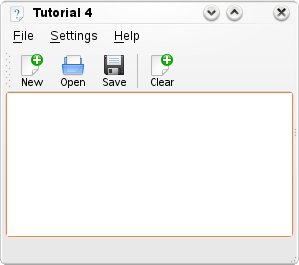Archive:Development/Tutorials/Saving and loading (zh CN): Difference between revisions
Tangooricha (talk | contribs) No edit summary |
Tangooricha (talk | contribs) mNo edit summary |
||
| Line 7: | Line 7: | ||
name=教程4 - 保存与装载| | name=教程4 - 保存与装载| | ||
pre=[[Development/Tutorials/Using_KActions|教程3 - KActions]]| | pre=[[Development/Tutorials/Using_KActions (zh_CN)|教程3 - KActions]]| | ||
next=[[Development/Tutorials/KCmdLineArgs|教程5 - 使用KCmdLineArgs]]| | next=[[Development/Tutorials/KCmdLineArgs (zh_CN)|教程5 - 使用KCmdLineArgs]]| | ||
reading=KIO::{{class|NetAccess}} {{qt|QFile}} | reading=KIO::{{class|NetAccess}} {{qt|QFile}} | ||
Revision as of 03:45, 13 September 2009
Development/Tutorials/Saving_and_loading
Languages: عربي | Asturianu | Català | Česky | Kaszëbsczi | Dansk | Deutsch | English | Esperanto | Español | Eesti | فارسی | Suomi | Français | Galego | Italiano | 日本語 | 한국어 | Norwegian | Polski | Português Brasileiro | Română | Русский | Svenska | Slovenčina | Slovenščina | српски | Türkçe | Tiếng Việt | Українська | 简体中文 | 繁體中文
| Tutorial Series | 初学者教程 |
| Previous | 教程3 - KActions |
| What's Next | 教程5 - 使用KCmdLineArgs |
| Further Reading | KIO::NetAccess QFile |
摘要
现在我们拥有了一个基本的文本编辑器的界面,已经到了做一些有用的事情的时候了。从最根本的来说,一个文本编辑器需要能够从磁盘中装载文件,并且能够创建新文件并保存你创建/编辑过的文件。
KDE提供了许多开发者易于使用的用于操作文件的类。KIO库允许你十分容易地像使用标准文件对话框一样通过网络访问文件。

代码
main.cpp
- include <KApplication>
- include <KAboutData>
- include <KCmdLineArgs>
- include "mainwindow.h"
int main (int argc, char *argv[])
{
KAboutData aboutData( "tutorial4", "tutorial4",
ki18n("Tutorial 4"), "1.0",
ki18n("A simple text area which can load and save."),
KAboutData::License_GPL,
ki18n("Copyright (c) 2007 Developer") );
KCmdLineArgs::init( argc, argv, &aboutData );
KApplication app;
MainWindow* window = new MainWindow();
window->show();
return app.exec();
}
main.cpp 与教程3中的相比没什么变化,除了说明参数从教程3变为了教程4。
mainwindow.h
- ifndef MAINWINDOW_H
- define MAINWINDOW_H
- include <KXmlGuiWindow>
- include <KTextEdit>
class MainWindow : public KXmlGuiWindow
{
Q_OBJECT //与教程3相比,新增加的
public:
MainWindow(QWidget *parent=0);
private:
KTextEdit* textArea;
void setupActions();
QString fileName; //新增加的
private slots: //新增加的
void newFile(); //新增加的
void openFile(); //新增加的
void saveFile(); //新增加的
void saveFileAs(); //新增加的
void saveFileAs(const QString &outputFileName); //新增加的
};
- endif
由于我们想要添加装载和保存文件的能力,所以我们必须添加将用来完成这些工作的函数。由于这些函数将会通过Qt的信号/槽机制被调用,所以我们必须注明这些函数是槽函数,就像我们在第19行做的那样。由于我们正在头文件中使用槽,所以我们同样必须添加Q_OBJECT宏。
我们同样想要跟踪当前打开的文件的文件名,所以我们申明了一个QString fileName。
mainwindow.cpp
- include "mainwindow.h"
- include <KApplication>
- include <KAction>
- include <KLocale>
- include <KActionCollection>
- include <KStandardAction>
- include <KFileDialog> //新增加的
- include <KMessageBox> //新增加的
- include <KIO/NetAccess> //新增加的
- include <KSaveFile> //新增加的
- include <QTextStream> //新增加的
MainWindow::MainWindow(QWidget *parent)
: KXmlGuiWindow(parent),
fileName(QString()) //新增加的
{
textArea = new KTextEdit;
setCentralWidget(textArea);
setupActions();
}
void MainWindow::setupActions()
{
KAction* clearAction = new KAction(this);
clearAction->setText(i18n("Clear"));
clearAction->setIcon(KIcon("document-new"));
clearAction->setShortcut(Qt::CTRL + Qt::Key_W);
actionCollection()->addAction("clear", clearAction);
connect(clearAction, SIGNAL(triggered(bool)),
textArea, SLOT(clear()));
KStandardAction::quit(kapp, SLOT(quit()),
actionCollection());
KStandardAction::open(this, SLOT(openFile()),
actionCollection()); //新增加的
KStandardAction::save(this, SLOT(saveFile()),
actionCollection()); //新增加的
KStandardAction::saveAs(this, SLOT(saveFileAs()),
actionCollection()); //新增加的
KStandardAction::openNew(this, SLOT(newFile()),
actionCollection()); //新增加的
setupGUI();
}
//从这里开始都是新增加的
void MainWindow::newFile()
{
fileName.clear();
textArea->clear();
}
void MainWindow::saveFileAs(const QString &outputFileName)
{
KSaveFile file(outputFileName);
file.open();
QByteArray outputByteArray;
outputByteArray.append(textArea->toPlainText().toUtf8());
file.write(outputByteArray);
file.finalize();
file.close();
fileName = outputFileName;
}
void MainWindow::saveFileAs()
{
saveFileAs(KFileDialog::getSaveFileName());
}
void MainWindow::saveFile()
{
if(!fileName.isEmpty())
{
saveFileAs(fileName);
}
else
{
saveFileAs();
}
}
void MainWindow::openFile()
{
QString fileNameFromDialog = KFileDialog::getOpenFileName();
QString tmpFile;
if(KIO::NetAccess::download(fileNameFromDialog, tmpFile,
this))
{
QFile file(tmpFile);
file.open(QIODevice::ReadOnly);
textArea->setPlainText(QTextStream(&file).readAll());
fileName = fileNameFromDialog;
KIO::NetAccess::removeTempFile(tmpFile);
}
else
{
KMessageBox::error(this,
KIO::NetAccess::lastErrorString());
}
}
